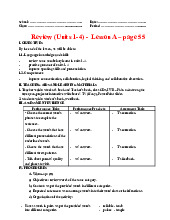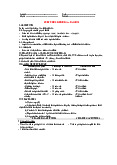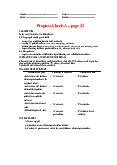




Preview text:
School: ………………………………………..
Date:……………………………………..
Class: …………………………….....................
Period: …………………………….........
CLIL A –PERSONAL, SOCIAL AND HEALTH EDUCATION - page 32 I. OBJECTIVES
By the end of the lesson, Ss will be able to:
1.1. Language knowledge and skills
learn how to deal with problems.
learn adjectives of feelings and emotions.
practise reading for main ideas and specific information (T/F).
practise presentation – how teens in Vietnam deal with problems. 1.2. Competences
improve communication, collaboration, logical thinking, and collaborative discussion. 1.3. Attributes
be aware of how to deal with problems with friends and family.
II. TEACHING AIDS AND LEARNING MATERIALS
1. Teacher’s aids: Student’s book and Teacher’s book, class CDs, IWB – Phần mềm tương tác trực
quan, projector/interactive whiteboard / TV (if any), PowerPoint slides.
2. Students’ aids: Student’s book, workbook.
III. ASSESSMENT EVIDENCE Performance Tasks Performance Products Assessment Tools
- Look at the title and guess the - Ss’ answers. - T’s feedback. context.
- Get to know some vocabulary - Ss’ taking notes. - T’s presentation words related to problems and how to solve them. - Read the passage about - Ss’ individual work. - T’s observation. dealing with problems in life. - Answer true-false questions. - Ss’ answers. - T’s feedback. - Matching headings. - Ss’ answers. - T’s feedback.
- Discuss and present about the - Ss’ group work. - T’s observation
way teens in Vietnam deal with - Ss’ answers/ presentation. - T’s feedback/ Peers’ problems. feedback. IV. PROCEDURES A. Warm-up: (5’)
a) Objectives: First, Ss activate their prior knowledge by sharing their personal experience
about etiquette in their family and community.
b) Content: Ss share their opinion about the questions.
c) Expected outcomes: Ss can activate and form some background knowledge for the reading topic.
d) Organization of the activity: TEACHER’S ACTIVITIES STUDENTS’ ACTIVITIES Group discussion
- Have Ss work in groups of 3 to share their answers to - Work in groups and answer the given the questions below. questions.
- Set the time limit for 3 minutes.
- Call for answers and share the background - Give answers.
knowledge about the questions.
1. Do you often argue with friends and family
Possible answers from Ss: members?
1. Yes, I argue with them every day/. No, I
2. What did you argue about?
don’t think so./ Well, I don’t often argue
with friends but I often argue with my mom./…
2. about study/ shopping/ what to eat/ … B. New lesson (35’)
Activity 1: Pre-Reading (10’)
a) Objectives: Ss preview and get to know the topic of the reading as well as the core vocabulary of the reading.
b) Content: Ss are introduced to vocabulary words related to the reading.
c) Expected outcomes: Ss grasp the basic knowledge within the lesson and understand the vocabulary words.
d) Organization of the activity: TEACHER’S ACTIVITIES STUDENTS’ ACTIVITIES
Task a. Guess the content of the reading. -
Have Ss work in pairs complete exercise 1 (SB, -
Complete the tasks with their partners. p.31).
- Set the time limit for 3 minutes. - Call for answers. -
Give answers/ Listen to their peers. - Give correction. - Check answers. Possible answers:
The text will provide information about how
people or family members can deal with problems.
Task b. Look at the new vocabulary and come up with the Vietnamese meanings.
- Have Ss work in pairs to guess the part of speech and - Complete the task with partners.
meanings of words. (This can tell what words Ss have
confidence about knowing and what words they definitely don’t know.) - Call for answers. - Give answers.
- Check answers as a whole class.
- Listen to the teacher and check their answers.
- Present and explain the new vocabulary words to the - Listen to the teacher and take notes class. (using IWB/ PPTs).
- Play audio and have Ss listen and repeat.
- Show the transcriptions of words and have Ss repeat. - Listen and say the word. - Correct Ss’ pronunciation.
- Look at the transcriptions and say the words.
Note: For a non-digital classroom (without IWB/ Answer keys
PPTs). T can write vocabulary on the board for Ss to
accept /əkˈsept/ (v): chấp nhận
guess. Then correct the answers with the whole class.
annoyed /ə n ˈ d
ɔɪ / (adj): khó chịu, bực mình
anxious /ˈæŋk. əs
ʃ / (adj): lo âu, lo lắng
blame /ble m ɪ / (v): đổ lỗi
confused /kənˈfju zd
ː / (adj): khó hiểu
disappointed /ˌd s.ə ɪ ˈp n.t ɔɪ ɪd/ (adj): thất vọng
Activity 2: While-Reading (13’)
a) Objectives: Ss identify their purpose for reading and develop a deep understanding of what to do
when having arguments with friends or family.
b) Content: Ss read the passage. Then complete the true-false task and fill in the gaps to complete the summary.
c) Expected outcomes: Ss can read for main ideas and specific information and learn some tips to deal with their own problems.
d) Organization of the activity: TEACHER’S ACTIVITIES STUDENTS’ ACTIVITIES
Task a. Read the passage and decide if the
statements are T (true) or F (false). -
Help Ss underline key words in each statement - Listen to the teacher. in exercise 2 (SB, p.32). -
Have Ss read and complete exercise 2 (SB, -
Work individually to complete the task. p.31). -
Ask Ss to take notes on the sentence containing - Highlight or underline.
the answers in the reading passage. -
Let Ss check their answers in pairs. -
Check answers with their partners. - Correct as a whole class. -
Listen to the teacher and check answers. Keywords:
1. Language – very important – solving problems.
2. Important – tell the other person – what – wrong.
3. Generation gap – not – affect – arguments.
4. Immediately – discuss – the problem.
5. Taking – small break – calm – down. Answer keys
1. T 2. F 3. F 4. F 5. T
Task b. Extra practice - Read and complete the summary. -
Have Ss read and complete the extra practice. -
Ask Ss to take notes on the sentence containing -
Work individually to complete the task.
the answer in the reading passage. -
Call for answers (or ask Ss to write their answers -
Give answers and explain/ Listen to
on the board) and ask Ss to explain their their peers. answers. - Correct as a whole class. - Check answers.
It is common for us to disagree with friends and
family on (1) ______ but what is more Answer keys:
important is trying to find a way to deal with 1. a variety of issues
them. When arguing with friends, it is better to 2. “I”
show them how you feel by using sentences 3. blaming
starting with (2)_____ instead of (3)_______ 4. understanding
them. Besides, you need to show your (4)______ 5. accept
their feelings and (5) ______ the truth that
6. years of life experience/ life experience
different people have different views of the 7. agree on
problems. In terms of family problems, it is
8. caring and communication
necessary to consider the generation gap.
Different members have different (6) ______.
Stay calm, sit down, and try to find a solution
that all members can (7) ______. We can solve
the problems with (8) ________.
Activity 3: Post-Reading (12’)
a) Objectives: Ss can make connections to the reading; identify adjectives of feelings and emotions and use them to share ideas.
b) Content: Ss discuss different ways that Vietnamese teenagers use to deal with problems.
c) Expected outcomes: Ss can present some solutions for teenagers.
d) Organization of the activity: TEACHER’S ACTIVITIES STUDENTS’ ACTIVITIES
Task a. Adjectives of feelings and emotions. -
Give a brief explanation of adjectives of - Listen to the teacher. emotions. -
Have Ss read the text again and complete -
Complete the task all by oneself. exercise 3 (SB, p. 32) - Call for answers. - Give answers. - Give feedback. - Check answers Answer Key
bad, angry, annoyed, confused, Task b. Project disappointed,
- Explain and instruct Ss to do exercise 4 (SB, p.31) anxious
- Have Ss work in groups of 4 or 5 (depending on - Listen to the teacher.
the number of Ss in the class) and assign each group -
Discuss in groups to complete the task.
a kind of problem and how to deal with it. (Some
groups will discuss what problems they have with
friends and how they deal with them. Other groups
will discuss what problems they have with family -
Give answers/ Listen to their classmates
members and how they deal with them). sharing.
- Set a time limit of 7 minutes.
- Ask some groups to present (T can ask all groups if - Listen to T’s feedback.
they have enough time) and other groups to give feedback - Give feedback.
C. Consolidation and homework assignments (5’) * Consolidation
- Write a short paragraph (about 80-100 words) about one problem you used to have or are having with
friends and one problem you used to have or are having with family and how you dealt with those
problems. You can use ideas from exercise 4 to complete this task. * Homework:
- Review the learned vocabulary in today’s lesson
- Do the exercises in WB: page 21
- Prepare: Progress check A (page 33 – SB). V. REFLECTION
a. What I liked most about this lesson today:
………….………………………………………………………………………………
b. What I learned from this lesson today:
…………………………………………………………………………………………
c. What I should improve for this lesson next time:
…………………………………………………………………………………………



